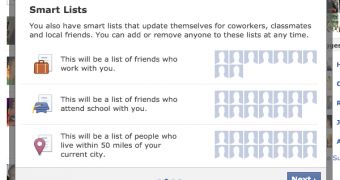Facebook is not taking the arrival of Google+ lying down. While the social network hasn't made too many public comments indicating that it's worried or even startled by the Google social network, it's been working on ways of combating the threat, even if it's a distant one.
And it's now debuting a very interesting feature aimed at not only being on par with Google+, but beating it.
Facebook has introduced Smart Lists which, as the name implies, are lists of friends that have been (smartly) grouped according to certain criteria.
For now, Facebook is creating lists automatically for your work buddies, school colleagues and people near you, more precisely, people within 50 miles of your city.
It's easy to see how these lists could come in rather handy, either for posting or sharing something that only the ones in that list will care about, or for following what's happening at your school or near you, for example.
The feature is in testing with a few users and it may see some tweaks before being rolled out more widely.
However, there is more to the update, apparently, Facebook will also make it easier to create custom lists, for example, for close friends or acquaintances.
The idea, again, is to make it easy to filter the ones you're sharing with or following up on.
If all of this seems a bit familiar, it's because the features bare a striking resemblance to Google+ Circles, the feature that got the most attention when the Google social network launched.
Circles are based on the idea of creating groups of friends, "circles," which are related in some way, for example, family, coworkers and so on.
Granted, Facebook has had this type of functionality too, but the way it was built into Google+ made a lot more sense. The new Facebook lists aim to replicate the simplicity of circles, but also one up Google+ with the Smart Lists. The main criticism of Circles is that, after a while, it become tedious to maintain too many of them and most people end up using two or three at the most.

 14 DAY TRIAL //
14 DAY TRIAL //